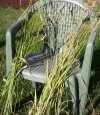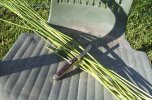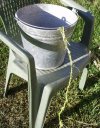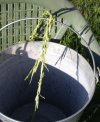- Joined
- Apr 13, 2007
- Messages
- 12,294
The natural cordage I use by far the most are Cedar roots. I just find these so great for virtually every application be it small roots for traps etc to thick monster roots for shelters or holding a raft together.
Anyway I decided to use some today to demonstrate how strong these are.
This is what I typically look for when harvesting the roots, a dead tree on it's side with plenty of exposed roots along it's length~

By pitdog2010 at 2011-08-15
I took the roots home today to prepare them. First of all I strip away the bark with my knife, this takes a little time but I think it's worth the effort. I then work my way along each root giving it a half twist to loosen up the fibres, you kinda feel it click as you do this~

By Pitdog2010 at 2011-08-15
This is my three lengths of roots all stripped and loosened up~

By Pitdog2010 at 2011-08-15
It's then just a case of anchoring one end and joining the roots with a basic braid, you should end up with something like this~

By pitdog2010 at 2011-08-15
I wasn't sure just how to show how strong this is so I got my kid to take a pic of me holding up 88 lbs in weight, I'm 100% confident I could have hung another 45lb on there if not two more !

By Pitdog2010 at 2011-08-15
As I mentioned before I also use thinner roots for traps such as this one I did~

By pitdog2010 at 2011-07-19
And this one~

By pitdog2010 at 2011-07-05
I'll maybe try and make some different cordage before the contest end.
I tested it out one more time, this time I had 175 lbs on and there was still no signs of it giving...only in my back....try doing that with ya nettles, LOL !

By pitdog2010 at 2011-08-15
Made some more today using a type of palm that I have growing in the garden~

By pitdog2010 at 2011-08-19
I managed to lift close to 30 lbs when I just looped it through a shackle and lifted it by hand but once I knotted it for a pic it felt like it would snap so I doubled it up~

By pitdog2010 at 2011-08-19
This time it held the weight very easily, I'm guessing I could have added another 10 lbs no problem~

By pitdog2010 at 2011-08-19

By pitdog2010 at 2011-08-19
Anyway I decided to use some today to demonstrate how strong these are.
This is what I typically look for when harvesting the roots, a dead tree on it's side with plenty of exposed roots along it's length~

By pitdog2010 at 2011-08-15
I took the roots home today to prepare them. First of all I strip away the bark with my knife, this takes a little time but I think it's worth the effort. I then work my way along each root giving it a half twist to loosen up the fibres, you kinda feel it click as you do this~

By Pitdog2010 at 2011-08-15
This is my three lengths of roots all stripped and loosened up~

By Pitdog2010 at 2011-08-15
It's then just a case of anchoring one end and joining the roots with a basic braid, you should end up with something like this~

By pitdog2010 at 2011-08-15
I wasn't sure just how to show how strong this is so I got my kid to take a pic of me holding up 88 lbs in weight, I'm 100% confident I could have hung another 45lb on there if not two more !

By Pitdog2010 at 2011-08-15
As I mentioned before I also use thinner roots for traps such as this one I did~

By pitdog2010 at 2011-07-19
And this one~

By pitdog2010 at 2011-07-05
I'll maybe try and make some different cordage before the contest end.
I tested it out one more time, this time I had 175 lbs on and there was still no signs of it giving...only in my back....try doing that with ya nettles, LOL !

By pitdog2010 at 2011-08-15
Made some more today using a type of palm that I have growing in the garden~

By pitdog2010 at 2011-08-19
I managed to lift close to 30 lbs when I just looped it through a shackle and lifted it by hand but once I knotted it for a pic it felt like it would snap so I doubled it up~

By pitdog2010 at 2011-08-19
This time it held the weight very easily, I'm guessing I could have added another 10 lbs no problem~

By pitdog2010 at 2011-08-19

By pitdog2010 at 2011-08-19
Last edited:



















































